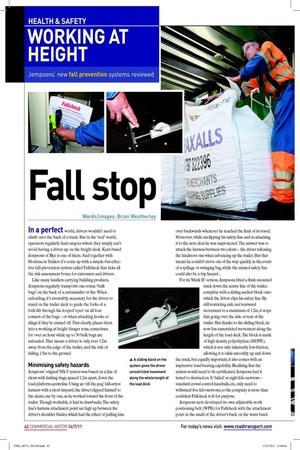Fall stop
Page 36

Page 37

If you've noticed an error in this article please click here to report it so we can fix it.
Words/images: Brian Weatherley
In a perfect world, drivers wouldn’t need to climb onto the back of a truck. But in the ‘real’ world, operators regularly haul cargoes where they simply can’t avoid having a driver up on the freight deck. Kent-based Jempsons of Rye is one of them. And together with Montracon Trailers it’s come up with a simple-but-effective fall-prevention system called Fallcheck that ticks all the risk-assessment boxes for customers and drivers.
Like many hauliers carrying building products, Jempsons regularly transports one-tonne ‘bulk bags’ on the back of a curtainsider or lat. When unloading, it’s invariably necessary for the driver to stand on the trailer deck to guide the forks of a fork-lift through the looped ‘eyes’ on all four corners of the bags – or when attaching hooks or slings if they’re craned off. That clearly places them into a working at height danger zone, sometimes for over an hour while up to 30 bulk bags are unloaded. That means a driver is only ever 1.2m away from the edge of the trailer, and the risk of falling 1.5m to the ground.
Minimising safety hazards
Jempsons’ original ‘Mk I’ system was based on a line of cleats with lashing rings, spaced 1.2m apart, down the load-platform centreline. Using an ‘off-the-peg’ fall-arrest harness with a short lanyard, the driver clipped himself to the cleats, one by one, as he worked toward the front of the trailer. Though workable, it had its drawbacks. The safety line’s harness attachment point sat high up between the driver’s shoulder blades, which had the effect of pulling him over backwards whenever he reached the limit of its travel. Moreover, while unclipping his safety-line and re-attaching it to the next cleat he was unprotected. The answer was to attach the harness between two cleats – the driver releasing the hindmost one when advancing up the trailer. But that meant he couldn’t move out of the way quickly in the event of a spillage or swinging bag, while the unused safety line could also be a trip hazard...
For its ‘Mark II’ version, Jempsons itted a lush-mounted track down the centre line of the trailer, complete with a sliding anchor block onto which the driver clips his safety line. By still restricting side and rearward movement to a maximum of 1.2m, it stops him going over the side or rear of the trailer. But thanks to the sliding block, he now has unrestricted movement along the length of the load deck. The block is made of high density polyethylene (HDPE), which is not only inherently low-friction, allowing it to slide smoothly up and down the track, but equally important, it also comes with an impressive load-bearing capability. Realising that the system would need to be certiicated, Jempsons had it tested to destruction. It ‘failed’ at eight kilo-newtons – standard crowd control handrails, etc, only need to withstand ive kilo-newtons, so the company is more than conident Fallcheck is it for purpose.
Jempsons next developed its own adjustable work positioning belt (WPB) for Fallcheck with the attachment point in the small of the driver’s back on the waist band. Thus, if his movement is checked as the slack is taken out of the lanyard, he’s not pulled over backwards (as he was with the previous harness). Shoulder braces also prevent the WPB from being pulled out of position.
Attaching the safety line
The harness, with lanyard and sliding block pre-attached, is neatly stowed in a plastic box conveniently at the rear of the trailer – so the driver can put it on before even climbing onto the platform. A high-vis vest can also be worn over it. To attach his safety line, the driver simply lifts a lap over the rear of the track, slides the grooved anchor block into it and closes the lap again. To avoid the possibility of debris jamming the block, four ‘clearance’ holes with weather protection beneath have been drilled along the track. So any stone that does fall into the track is pushed along by the block before dropping through the nearest hole. There’s also a larger ‘vent’ at the rear of the track and the slider block has good clearance too. In trials, jamming has not been a problem, the system gaining a strong approval from the company’s drivers.
Jempsons has applied for international (worldwide) patents for its Fallcheck system and more recently has struck a UK licensing agreement with Montracon, which will offer it on new trailers as an on-line option, or it can be easily retro-itted, either at Montracon’s York repair centre – or supplied as a kit to approved workshops . The one-piece grooved alloy track attaches to the trailer’s cross members and matches the industry-standard 29mm trailer loor. Price is on application , although leet buyers could expect a discount on volume.
Meanwhile, Fallcheck has already been demonstrated to a number of Jempsons’ customers (including those major leets it works with as a logistics partner) and feedback has been extremely positive. The comment from Anthony Ball, regional operations manager for TDG, was typical of the praise Fallcheck has collected: “The system is a real breakthrough in vehicle-related health and safety; anyone who has to work on a trailer bed is now completely safe from falling off. It is extremely user-friendly and doesn’t appear to impede the person wearing it. This system will prevent accidents.” ■













































